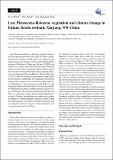Late Pleistocene-Holocene vegetation and climate change in Ebinur Betula wetland, Xinjiang, NW China
Date
15/10/2020Metadata
Show full item recordAbstract
Late Pleistocene-Holocene has been regarded as one of the most important periods in the history of climate change. The specific objectives of this study were to restore vegetation change and climatic evolution in the Ebinur Betula wetland of Xinjiang in China over the past 16,000 years based on 15 surface and 70 fossil pollen data. Research results revealed that a relatively humid climate existed from 12,230 to 9,260 cal. aBP, followed by a reducing humidity period between 9,260 cal. aBP and 3,303 cal. aBP. After 3,303 cal. aBP, the aridity increased further, especially in the last 600 years. Additionally, three high peaks of the Betula pollen in this wetland occurred at the end of the Last Glacial Maximum, at the beginning of early Holocene and during the Medieval Warm Period, all of which pointed to the amelioration of climatic conditions. However, the percentage of Betula has also been on a declining trend in the past 600 years, indicating a drying climate and intensified human activities. Therefore, these findings are conducive to exploring the impacts on wetland vegetation caused by climate change and anthropogenic disturbance in different periods, and providing the reference frame for wetland restoration and ecological construction in China.
Citation
Wang , L , Zhang , Y & Kong , Z 2020 , ' Late Pleistocene-Holocene vegetation and climate change in Ebinur Betula wetland, Xinjiang, NW China ' , Episodes , vol. Online First . https://doi.org/10.18814/epiiugs/2020/020085
Publication
Episodes
Status
Peer reviewed
ISSN
0705-3797Type
Journal article
Description
The work was supported by the National Natural Science Foundation of China (Grant No. 41971121 and 41572331), the Strategic Priority Research Program of the Chinese Academy of Sciences (Grant No. XDA19050103), and the Scientific Research Foundation for the Returned Overseas Chinese Scholars, State Education Ministry.Collections
Items in the St Andrews Research Repository are protected by copyright, with all rights reserved, unless otherwise indicated.

